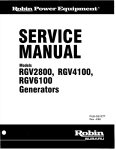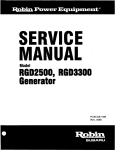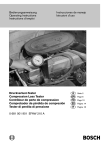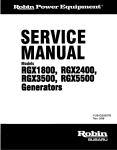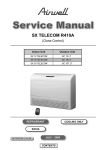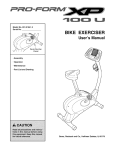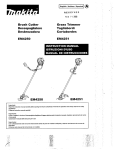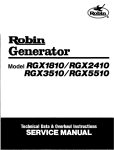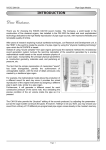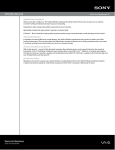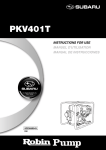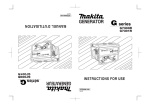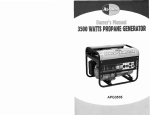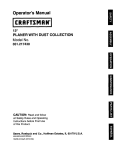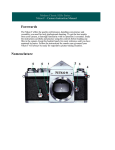Download Subaru Robin Power Products RGV7500 User's Manual
Transcript
SERVICE MANUAL Model RGV7500 PlJB-GS1436 Rev. 05/00 Section Title Page l.'SPECIFICATIONS....................................................................................................... 1 2 PERFOMANCE CURVES........................................................................................... 2 3. FEATURES .................................................................................................................. 3 . 3-1 A.V.R. ALTERNATOR ............................................................................................. 3-2 OIL SENSOR ........................................................................................................ ............................................................................................. 3-4 NO RADIO NOISE ................................................................................................ 3-5 LARGE FUELTANK .............................................................................................. 3-6 RUGGED TUBULAR FRAME ............................................................................... 3-7COMPACT AND LIGHT WEIGHT......................................................................... 3-8 MINIMAL MAINTENANCE .................................................................................... 3-9 LONG-LIFE DURABILITY ..................................................................................... 3-3 QUIET OPERATION 3 3 3 3 3 3 3 3 4 5 4. GENERAL DESCRIPTION.......................................................................................... 4-1 EXTERNAL VIEW ................................................................................................. 5 4-2 CONTROL PANEL ................................................................................................ 6 4-3 LOCATION of SERIAL NUMBER and SPECIFICATION NUMBER ......................6 5 CONSTRUCTION AND FUNCTION 7 5-1CONSTRUCTION .................................................................................................. 7 5-2 FUNCTION ............................................................................................................ 7 5-3 GENERATOR OPERATION ................................................................................ 13 5-4 OIL SENSOR ...................................................................................................... 16 6 SAFETY PRECAUTIONS ......................................................................................... 19 7 RANGE OF APPLICATIONS 20 8 MEASURING PROCEDURES 23 8-1 MEASURING INSTRUMENTS........................................................................... 23 8-2 AC OUTPUT MEASURING................................................................................. 26 8-3DC OUTPUT MEASURING................................................................................. 26 8-4 MEASURING INSULATION RESISTANCE ........................................................ 27 9 CHECKMG FUNCTIONAL MEMBERS 29 9-1 V O L f M t r E R ....................................................................................................... 29 9-2AC RECEPTACLES ............................................................................................ 29 29 9-3 No-FUSE BREAKER ........................................................................................... . ........................................................................... . . . .................................................................................... .................................................................................. . .................................................................... Title . Page 9-4STATOR .............................................................................................................. 30 Sectior! ........................................................................................... 30 9-6 BRUSH................................................................................................................ 31 9-7 A.V.R. (AUTOMATIC VOLTAGE REGULATOR).................................................. 31 9-8 IDLE CONTROL UNIT ........................................................................................ 9-9 DIODE RECTIFIER............................................................................................. 33 9-10 OIL SENSOR .................................................................................................... 35 9-11 EXCITING COIL ................................................................................................ 35 9-5 ROTOR ASSEMBLY 1O.DISASSEMBLY AND ASSEMBLY 34 ........................................................................... 10-1PREPARATION and PRECAUTIONS ................................................................ 10-2 DISASSEMBLY PROCEDURES ....................................................................... 36 . 36 37 10-3ASSEMBLY PROCEDURES ............................................................................ 45 10-4 CHECKING, DISASSEMBLY and REASSEMBLY ofthe FRONT PANEL ........50 11.TROUBLESHOOTING ............................................................................................ 11-1 NO AC OUTPUT ................................................................................................ 11-2 AC VOLTAGE IS TOO HIGH OR TOO LOW ..................................................... 11-3 AC VOLTAGE IS NORMAL AT NO.LOAD. BUT THE LOAD CANNOTBE APPLIED ..................................... 11-4 NO DC OUTPUT................................................................................................ 11-5 IDLE CONTROL(OPTI0NAL EQUIPMENT) ..................................................... 12 WIRING DIAGRAM ................................................................................................. . 52 52 53 \ I 54 55 56 59 NOTE :As forthe servicing information on engine protion. pleasereferto theEH41 engine sewice manual. 1. SPECIFICATIONS j: Model RGV7500 Brush, Self Exciting, 2-Pole, Single Phase 60 Hz ~~ ~ ~ ~ Maximum Output 7300 W Rated Output 6000 W U Voltage Rated Current Power Factor DC Output Regulator Voltage 120V1240V I V-8.3 12 A (100 W) I I Type AVR I I Air-Cooled 4-Cycle, Overhead Valve Gasoline EngineI 1.o EH41D Model in.) (24.63 cu. cm3 404 Displacement 9.5 Rated Output I hours 7.0 Approx. Dry Weight I I I I 0.32 U S . gal. (1.2 liters) Oil Capacrty Dimensions (L x Wx H) I 7.26 U.S. gal. (27.5 liters) Fuel Tank Capacity Starting System HP I 3600 rpm Automobile Gasoline Fuel Rated Coutinuous Operation 50N25A I Recoil Starter and Optional Electric Starter 27.2 x 20.9 x 20.9 in. (690 x 530 x 530 mm) 198.4 Ibs. (209.4 Ibs.)' 190 kg (95 kg)* * Electric starter motor is availableasoption. - 1- I 2. PERFOMANCE CURVES RGV7500 / 60 Hz (6.0kVN240V) Load Rated DC OUTPUT DC Voltage................. 12 V DC Ampere ................ 8.3A DC output................... 100 W The voltage curve shownin the left indicates the characteristicof DC output when charging a battery. The voltage may be decreasedby 20% when the resistanceload is applied. NOTE :It is possible to use both DC and AC outputs simultaneously up to the rated output in total. - 2- f \ 3. FEATURES 3-1 AVR ALTERNATOR Output votage becomes more stable due to AVR system. 3-2 OIL SENSOR Oil sensor automatically shutsoff the engine whenever theoil level fallsdown below the lowerlimit to protect the engine from seizure. 3-3 QUIET OPERATION Robin RGV series generator delivers a quiet operation with : A quiet 4-stroke Robin Rro OHV engine. Extra large muffler and large air cleaner provide remakable quiet operation. 3-4 NO RADIO NOISE Noise suppressor spark plugis equipped standardto prevent radio frequency interference. 3-5 LARGE FUELTANK The large fuel tank (27.5 L) allows more than7 hours of continuous operation which is sufficient for a half day or one day work without refueling. 3-6 RUGGED TUBULAR FRAME Full cradle type rugged tubuler frame protects the generator all around. ". 3-7 COMPACT AND LIGHT WEIGHT Newly developed brushless alternator enabled the RGV generators to be very compact in size and light in weight. 3-8 MINIMAL MAINTENANCE A drip-proof alternator design. No-fuse circuit breakers. An electronic pointless ignition system. - 3- 3-9LONG-LIFE DURABILITY The heavy-duty 4 stroke Robin OHV engine : Full rubber mount in a sturdy tubular frame. * A forged steel crankshaft supported by two main ball bearings. A pointless electronic ignition system. * A cast-iron cylinder liner. * I \ - 4- 4. GENERAL DESCRIPTION 4-1 EXTERNAL VIEW FUEL GAUGE CONTROL PANEL AIR CLEANER RECOIL STARTER IL GAUGE (OIL FILLER) SENSOR OIL DRAIN PLUG OIL FUEL TANK CHOKE LEVER SPARK PLUG CAP OUTLET - 5- 4-2 CONTROL PANEL HOUR VOLTMETER METER :\.ET3iSTARTER \ IDEL TYPE) : ; F E Y I \ ’ BREAKER SWITCH \ PILOT LAMP A K C L E I I NO-FUSE DC OUTPUT TERMINAL DC CIRCUIT BREAKER SWITCH ENGINE (RECOIL STARTER TYPE) 4-3 LOCATION of SERIAL NUMBER and SPECIFICATION NUMBER Serial number and specification number are stamped onthe LABEL (MODEL NAME) stuck on the side wall of rear cover. I NOTE :Always specify these numbers when inquiring about the generator or ordering spare parts in order to get correct parts and accurate service. LABEL, MODEL NAME - 6- 5. CONSTRUCTION AND FUNCTION 5-1 CONSTRUCTION STATOR. COMPLETE COVER TROUGH FRONTBOLT EARING BALL RUBBER MOUNT Fig. 5 1 5-2 FUNCTION 5-2-1 STATOR The stator consists of a laminated silicon steel sheet core, a main coil and a condenser coil which are wound in the core slots. The condensercoil excites the rotor field coil which generates AC voltage in the main coil. 3 Fig. 5-2 - 7- 5-2-2 ROTOR The rotor consistsof a laminated siliconsteel sheet core and a field coil which is wound overthe core. DC current in the field coil magnetizes the steel sheet core. Two permanent magnets are provided for the primary exciting action. Slip rings are provided on the rotor shaft to receive DC exciting current from A.V.R.. Fig. 5-3 5-2-3 BRUSW BRUSH HOLDER An exciting current is supplied from the A.V.R to the rotor. The brushes are made of carbon and the brush-holder of plastic. It is necessary to keep the contact pressure between the brushes and slip rings withing specific limits. Thus, care must be taken of brush length. Fig. 5-4 5-2-4 A.V.R. (AUTOMATIC VOLTAGE REGULATOR) The automatic voltage regulator employs an elec- tronic circuit to automatically regulate voltage. ~ Fig. 5-5 - a- 5-2-5 IDLE CONTROL UNIT The idle control unit releases throttle valve when the applied load current exceeds 0'.04A. The two output wires from the main coils must go through theZCT in the same direction. NOTE : It is normal that the engine speed goes up for a moment when you turn the key switch to "STOP" while the Auto Idle Switchis in "ON" position. I Fig. 5-6 5-2-6 NO-FUSE BREAKER The no-fuse breaker protects the generatorfrom getting damageby overloading or short circuitin the appliance. Table5-1 shows the capacity of no-fuse breaker by each spec. and their object of protection. I SPECIFICATION NO-FUSE BREAKER 60 HZ-120 V/ 240V 25 A (2-Pole, 2-Element) OBJECT of PROTECTION ' Total output amperage Table. 5-1 5-2-7 DC CIRCUIT BREAKER The 10 ampere DC circuit breaker mounted on the control panel protects wholeDC circuit from getting damage by overload or short circuit. Fig. 5-7 - 9- Table. 5-2 1 Caution : The duplex 120V receptacle is protected by a GFCl (Ground Fault CircuitInterrupter). GFCl shuts off the output current from the duplex 120V receptacle when a ground fault occurs in the generator or the appliance. Please note thatother receptacles arenot protected by GFCI. \ TWIST 1 Caution :To connect theappliance to locking receptacle, insert theplug into the receptacle and turn it clockwise to lock. - 10- 5-2-9 GFCI RECEPTACLE After starting the engine, check the GFCI for'proper functioning by the following test procedure. Push blue TEST button, The red RESET button will pop out exposing the word TRIP. Power is now off at the outlets protected by the GFCI, indicating that the device is functioning properly. If TRIP dose not appear when testing, do not use the generator. Call a qualified electrician. To restore power, pushRESET button. WARNING : If the RESET button pops out duringoperation, stop thegenerator immediately and call a qualified electrician for checking generator andthe appliances. 5-2-10 CONNECTING TO DOMESTIC CIRCUITS(HOUSE WIRING) Fig. 5-9 WARNING : . This generator is a neutral grounded type. ff a generator is to be connected to residential or commercial power lines, such asa stand-by power source during power outage, all connections must be made by a licensed electrician. Faitwe in connection may result indeath, personal injury, damageto generator, damageto appliances, damage to the building's wiringor fire. (a) When contnecting a Robin generatorto a house wiring, generator output power must be taken from the 240V-4P receptacle. - 11 - Utility high line House circuitbreaker - I v I I I I 120v - I ,A" appliance 240V 120v appliance I appliance I I " " " " " " " " " " " " " " " " " = 4P-Receptacle Fjg. 5-70 (b) Install Ii A transfer switch must be installed to transfer the load from the commercial power sourceto the 1 generator. This switchis necessary to prevent accidentscaused by the recovery from power outage. ' Use a transfer switch of the correct capacity. Install transfer switch between the meter and the AC breaker box. Caution : If the neutral wireof house wiring is grounded,be sure to ground the ground terminal of the generator. Otherwise an electric shock may occurthe to operator. (c) Operating the generator. Set the full power switch 120W to 240V side. Turn the house AC breaker off before starting the generator. it up. Start the generator and warm Turn the houseAC breaker on. with electrical appliance(s) connected and with their switches on. Caution : Do not start the generator at starting. Otherwise the appliance(s) may be damaged by the surge voltage i - 12 - 5 3 DESCRIPTION Of GENERATOR OPERATION 5-3-1 PRIMARY EXCITING ACTION When the generator is started, the permanent magnet on the engine rotates to generator a voltage in the exciting coil. This voltage is regulated FC by a diode in the A.V.R. to feed a current to the generator field coil. (FC). (See Fig. 5-11) n The rotoris turned an electromagnet by that current and rotatesso that voltage are generated in the stator coils (main coil and sub coil). The voltage generated in the sub coils is operatedby the A.V.R. to feed a current to increase the field coil current. (See Fig. 5-12) EC L""""""-J ENGINE MAGNETO Fig. 5-11 As a result, the rotor magnetism increases. This operation is repeated to generate the rated voltage at60 Hz in the main coil andDC coil. 5-3-2 VOLTAGE REGULATING MECHANISM Connect a load to the AC output terminal and increase current. Output voltage varies as shown in Fig. 5-13 depending on whether an automatic voltage regulatoris used or not. The operationof the A.V.R. is explained below. When an AC output is taken, the engine is loaded and its rpm falls, Also the AC voltage fails due to the voltage drop caused by the internal resistance of the coils. TheA.V.R. detects this voltage drop and its built-in SCR automatically increase the current flowsto the field coil. As a result, the rotor magnetism increase, the voltage fallen by the load current is raised: and the output voltage is kept constant. If the AC output is reduced, the SCR operates in the opposite way to similarly keep the output voltage constant.co,ndenser coil. When current a increases, the density of magnetic flux across the rotor core rises. As a result, the current flowingin the fieldcoil increases and the generator output voltage is prevented from decreasing. - 13- i Fig. 5-12 WITHOUT AVR RATED VOLTAGE v I 4 A Fig. 5-13 5-3-3FULL POWER SWITCH (Dual Voltage Type) The full power switch is provided for the dual voltage type to take out the full rated power from one receptacle in each voltage. r--- 1 120/240v MC1 240v -- 1 t.Fig. 5-14 MC1 MC2 1 Fig. 5- 15 - r 1REC.~ Switch Position LOWER VOLTAGE HIGHER VOLTAGE RECEPTACLE RECE MC1 1 120/240 V RECB Half of rated output Table. 5-3 -MC2 Fig. 5-16 - 14- Rated output I I Two main coils are wound over stator core. Each maincoil outputs half the rated power at the lower voltage (120V). These main coils are wound to be in the same phase. Thefull power switch reconnects these main coilsin parallel or in series. Fig. 5-14 shows acircuit diagram. When thefull power switchis set for single lower voltage indication (120V), the switch positionis as indicated by the lower solid line in the diagram. Fig. 5-15 is a simplified representation of this circuit, showing thetwo main coils connected in parallel. In this case, the higher voltage (240V) at Rec. 3 cannot be taken out.Rec. 2 for the lower voltage can outputup to the rated power (upto 30A if the rated currentis over 30A), and Rec. 1 can output up to a totalof 15A. When the full power switch is set for double voltage indication (120V/240V), the switch position is as indicated by theupper dotted line in Fig. 5-14. Fig. 5-16 is a simplified representationof this circuit, showing the two main coils connectedin series. In this case, power can be taken simultaneously from the receptacles for the both voltages. Rec. 3 for the higher voltage can outputtoup the rated power, but Rec. 1 and Rec. 2 for the lower voltage can output only up to half the rated power each. ' fullby power switchin Table 5-4is a summaryof the above explanation. Select.the proper output voltage accordance with the appliance to be used. - 15- 5-4 OIL SENSOR 5 4 1 DESCRIPTION The oil sensor mainly functionsto detect position of the surface of engine oil in the crankcase of engines for general use and to stop the engine automaticallywhen the oil level goesdown below the lower limit specified.This prevents seizure of engine from occurringdue to insufficient amount of oil in the crankcase. OIL SENSOR Since the sensor has been designed to.consume a part of power supplied to the igniterto energize its electronics circuit, any other external power supply is not necessary so that it can be Fig. 5- 17 mounted at the oil filler port. Introduction of newly developed sensing principle features super durability and no change with the passage of time as it does not use any moving part. Merits due to introduction of electrical conductivity detection are as follows ; @ It has resistance to mechanical shocks and property of no change with the passage of time as sensing element consists simply of electrodes having no moving parts. @ At the same time, it is capable of detecting the oil level stably as it is not influenced by engine vibrations. @ No error occurs due to foam and flow of the oil. @ Influence I against the ignition system or the electronics units c a n be neglected because an electric current supplied to the sensor can be decreased. 5-4-2 PRINCIPLE OF SENSING OIL LEVEL There is a great difference between electric resistanceof air and that of oil. Since the resistanceof air is far higher than thatof oil, more electric current passes through the oil than through the air, although absolute valueof the currentis very small. The sensor detects this current difference andmake use of it. The sensor judges the oil quantity,by comparing a current flowingacross apair of electrodes (innerand outer) with the reference, in such a way that if a current flows between the electrodesmore than the reference, sufficient oilis in the crankcase, on the other hand, if a current flows less than the reference, oil is not sufficient. Since an electric current is flown to detect oil quantity, this is called the “electrical conductivity detection” typeof sensor. The oil level to be detected is determined by the length of electrodes and their mounting positions with the engine. 5-4-3HOW IT OPERATES [Power supply] The sensor makes useof a part of primary power sourcefor ignition of the engine (igniter) to drive the sensor circuit. Power tothe sensor can usually be derived from the “stop button”by branching wires out. - 16- [Judgement of oil level] When sufficient oilis in the crankcase, both of inner and outer electrodes are immersed in the oil through which current flows across the electrodes. The sensor judgesoilthat in the crankcase is sufficient. When oil level goes down and the inner electrode is exposed to the air due to consumption of oil, no c between the electrodes as airis considered to be electrically nonconductive. The sensor in this case judges that oil is insufficient. [Decisionof oil shortage] .Oil level at the electrodes may go down momentarily probably due to the engine being slanted or by vibration even if a sufficientoil is in the crankcase. For that reason, the sensor has an electronic time circuit to preventit from interpreting as short of oil when amount ofoil is sufficient. The sensor has been designed so that the engine is to be stopped only when oil-shortage is detected 5 seconds for uninterrupted. The timer employs an integration circuit itand is tobe reset when the inner electrode is soaked in the oil again before the sensor decides it as oil-shortage. The oil level where the sensor decides oilas shortage, when oil levelgoes down gradually,is called "threshold level". [Automatic stop of engine] When the sensor decides as oil-shortage,it makes the engine to stop running automatically for protection of engine. Oncethe stopping circuit is activated, it keeps functioning until it confirms that the engine has made a complete stop, then the circuit stops functioning automatically. 5-4-4 BLOCK DIAGRAM OF THE CIRCUIT Power circuit Innerpole oil 1 - Detection circuit - Deley circuit igniter Stopping circuit ' + -Pole Engine Fig. 5-18 0 Power circuit ..........This rectifies a part of power to the igniter and regulates it to supply thest&+ lized powerto necessary circuits. - 17- @ Detection circuit..... This detects quantity ofoil, sufficient or not, accordingto difference of electric resistance across inner and outer electrodes. @ Delay circuit...........This his prevents the sensor from making an unnecessary stop of the engin by momentary lowering of theoil level due to the engine being slanted or affected by vibrationin spite of sufficient oilin the crankcase. @ Stopping I circuit...... This automatically stops the engine running. 5-4-5 CAUTIONS TO BE TAKEN ON HANDLING THE SENSOR (1) Oil sensor unit 0 Be sure not to damage each wire. Broken or short-circuited power supply wires and/or a ground ing wirein particular may leadto malfunction or breakdown. @ The sensor is not interchangeable from engine to engine because the sensor is to be exclus installed individually in each engine employed. (2) Mounting and wiring of oil sensor unit 0 Although this has been designed to have enough antinoise properties in practical use, do not route the sensor wiringsin the vicinity of noise-generating sources such as ignition plugsor high voltage cords. This may cause malfunction or breakdown. I \ @ Since capacity of power sourceis limited, current flown in the electronic circuit of the sensor is kept as low as possible. Be sure to use terminals with a high contact reliability of more than o that f tinned terminals. (3) Operation of oil sensor @ If operating with the engine kept tilted, oil surface inside of the engine varies and the correct oil ~ level can not to be detected whichin turn obstructs the preventing functionof engine seizure. Operate the engine by keeping it level. I @ When starting the engine with an insufficient oil in the crankcase, engine starts onceitthen stops I after automatically for it runs i 5 seconds. @ When the engine has been stoppedby the oil sensor, voltage remained in the electronic circuit prevents the sensor from being restarted for3 seconds after the engine stop. Tryto restart the engine after3 seconds or more. - j 18- i ~ 6. SAFETY PRECAUTIONS 1. Use extremecaution near fuel. A constant danger of explosion or fire exists. Do not fillthe fuel tank while the engine is running. Do not smoke or use open flame near the fuel tank. Be careful notto spill fuelwhen refueling. If spilt, wipeit and let dry before starting the engine. 2. Do not place inflammablematerials near the generator. Be careful notto put fuel, matches, gunpowder, oily cloth, straw, and any other inflammables near the generator. 3. Do not operate the generator in a room, cave or tunnel. Always operate in a well-ventilated area. - Othetwise the enginemay overheat and also, the poisonous carbon monoxide containedin the exhaust gaseswill endanger human lives. Keep the generator at least 1 m (4 feet) awayfrom structures or facilities duringuse. 4. Operate the generator on a level surface. If the generatoris tilted or moved during use, there is a dangerof fuel spillage and a chance that the generator maytip over. 5. Do not operate with wet hands or in the rain. Severe electric shock may occur. If the generatoris wet by rain or snow, wipe it and thoroughly dry it before starting. Don’t pour water over the generator directly nor wash it with water. If the generator is wet with water,.the insulations will be adversely affected and may cause current leakage and electric shock. 6. Do not connect thegenerator to thecommercial power lines. or damage to the generator. Use a transfer switch (Optional parts) for This may cause a short-circuit connecting with indoor wiring. NOTE :The parts numbersof the transferswitches and of the plastic box to store them are as shown in Table 6-1. ~ Name Part No. Part 36545604-08 Switch Transfer 1 Phase Allowable Q’ty Current 1 1 15 A 367-45605-08 Transfer Switch 1 1 30 A 340-45606-08 Transfer Switch 1 1 60 A 367-43008-08 Plastic Box 1 1 30 A 34843009-08 I I Plastic Box 1 I 1 I 60 A Table. 6-1 7. Be sure to check and remedy the cause of circuit.breaker tripping before resetting it on. CAUTION :ff the circuit breaker tripped off as a result of using an electrical appliance, the cause can be an overloador a short-circuit.In such acase, stop operation immediately and carefully check the electrical appliance and AC plugs for faulty wiring. - 19 - 7. RANGE OF APPLICATIONS Generally, the power rating of an electrical appliance indicates the amount of work that can be done by it. The electric power requiredfor operating an electrical applianceis not always equalto the output wattage of the appliance.The electrical appliancesgenerally have a label showing their rated voltage, frequency, and power consumption (input wattage). Thepower consumption of an electrical appliance is the power necessary for using it. When using a generator for operating an electrical appliance, thepower factor and starting wattage must be taken into consideration. In order to determine the right size generator,it is necessary to add the total wattage of all appliances to be connected to the unit. Refer to the followings to calculate the powerconsumption of each applianceor equipment by its type. (1) Incandescent lamp, heater, etc. with a power factor of 1.0 Total power consumption must be equal to or less than the rated output of the generator. Example :A rated 3000W generator canturn thirty 1OOW incandescent lampson. (2) Fluorescent lamps, motor driven tools, light electrical appliances, etc. with a smaller power factor Select a generator with a rated output equivalent to 1.2 to 2 times of the power consumption of the load. Generally the starting wattage of motor driven tools and light electrical appliances are 1.2 to 3 times lager thantheir running wattage. Example : A rated 250 W electric drill requires a 400 W generator to start it. NOTEl :If a power factor correction capacitor not is applied to the fluorescent lamp, the more power shall be requiredto drive the lamps. NOTE2 :Nominal wattage of the fluorscent lamp generally indicates the output wattage of the lamp Therefore, if the fluorescent lamp has no special indication as to the power consumption, ciency should be taken into account as explained in(5) Item on the following page. (3) Mercury lamps with a smaller power factor Loads for mercury lamps require2 to 3 times the indicated wattageduring start-up. Example :A 400 W mercury lamp requires800 W to 1200 W power source to be turned on. A rated 3000 W generator can power two or three 400 W mercury lamps. (4) Initially loaded motor driven appliances such as water pumps, compressors, etc. These appliances require large starting wattage whichis 3 to 5 times of running wattage. Example :A rated 900 W compressor requiresa 4500 W generator to drive it. NOTEl :Motor-driven appliances require the aforementioned generator output only at the starting. their motors are started, the appliances consume about 7.2 to 2 times their rated power consumption so that the excess power generated by the generator can be used for other electrical appliances. NOTE2 :Motor-driven appliances mentioned in items (3) and (4) vary in their required motor starting it is difficun to determine the optimum power dependingon the kind of motor and start-up load. If generator capacify, select a generator with a larger capacity - 20- ' * 8' (5) Appliances without any indicationas to power consumption Some appliances have no indication asto power consumption; but instead the work load (output)is indicated. In such a .case, power consumption is to be worked out accordingto the numerical formula mentioned below. (Output of electrical appliance) = (Power consumpition) (Efficiency) : Eff iciencies.of some electrical appliances are as follows Single-phase motor................................ 0.6 t0 0.75 Fluorescent lamp ................................... 0.7 to 0.8 The smaller the motor, the ( lower the efficiedCY. Example 1: A 40W fluorescent lamp means that its luminous output is 40W. Its efficiency is0.7 and accordingly, power consumption will be 40+ 0.7=57W. As explained in Item (2),multiply this power consumption value of 57 W by 1.2 to 2 and you will get the figure of the necessary capacity of a generator. In other words, a generator with a rated output of O 1OOW capacity can light nine to fourteen 40 W fluorescent lamps. Example 2 :Generally speaking, a400 W motor means thatits work load is 400 W. Efficiency of this motor is 0.7 and power consumptionwill be 400+0.7= 570 W. When this motoris used for a motor-driven tool, the capacity ofthe generator should be multiple 570 of W by 1.2to 3 as explained in the Item(3).570 (W) x 1.2 to 3 = 684 (W) to 1710 (W) I I Frequency I etc. heater, lamp, lncandesent 60 Hz 6000 W Fluorescent lamp, Motordriven tool, general-potpose approx. 3000 W 2000 W Mercury lamp, etc. approx. Pump, compressor, etc. approx. 1400 W Table. 7-1 - 21 - I NOTES :Wiring between generator and electrical appliances 1. Allowable current of cable Use a cable with an allowable current that is higher than the rated input current of the load appliance). If the input current is higher than the allowable current of the cable used, the cable will become excessively heated and deteriorate the insulation, possibly burning it out. Table 7-2 shows cables and their allowable currents for your reference. 2. Cable length If a long cable is used, a voltage drop occurs due to the increased resistance in the conductors creasing the input voltage to the load (electtical product). As the load can be damaged. Tabl a result, 7-2shows voltage drops per100 meters of cable. i Resistance Allowable Sectional wire e,ement No’ ohm”00m area / mm3 current / A mm 0.75 7 1.25 12 23 5.5 35 3.5 per 100 m 1A 3A SA 2.477 2.5 V 8V 12.5 V , 5 0/ 0.18 1.486 1 . 5 ~ sv 37 I 0.26 17 0.952 1.OV 3V 5.0V 8V 1OV 45 I0.32 0.517 1.5 V 2.5 V 4V 5V 6.5 U 7.5 V 70 J 0.32 0.332 1V 2V 2.5V 3.5V 4V 5V 30 10.18 2.0 Voltage drop 15A 8A 1 5 ~ 1av 1 2 ~ 15V Table. 7-2 1 10 0x R x I x L Voltage drop indicates as V= R means resistance ( SZ / 100 m) on the above table. I meanselectriccurrentthroughthewire L meansthelength of thewire(m). (A). The lengthof wire indicates round length, it means twice the length from generator to electricaltools. - 22- 12 12V ( 8. MEASURING PROCEDURES 8-1 MEASURING INSTRUMENTS 8-1-1 "Dr. ROBIN" GENERATOR TESTER. The "Dr. Robin" generator tester is exclusively designed for fast, easy diagnosisand repair of Robin generators. The "Dr. Robin" has the following features: (1) Functions of voltmeter, frequency meter, megger tester, capacitance meter and circuit tester are combined in one unit. (2)Fast and easy readout by digital indicator. (3) Built-in automatic battery checker indicates the time to change batteries. Fig. 8-1 (4) Tester and accessories are installed in a handy, sturdy case for easy carrying. SPECIFICATIONS Dr. Robin MODEL Part Number I 388-47565-08 0 to 500 V AC Voltage I Frequency I to ~~ Measuring Resistance Range Condenser Capacity 25 70 Hz I 0.1 to 1.999 Q 10 to 100 p F Insulation Resistance 3M Q Circuit Protector Fuse I Power Source I Accessories 2 x 6F44P (006P) Dry Battery Cell Test leads with needle probes. . . 1 set Testleads with jack plugs . . . 1set Dimensions (L x W x H) I I 285 mm x 200 rnm x 110 mm 1.6 kg Weight Table. 8-1 The "Dr. Robin" generator tester can be ordered from Robin generator distributors by the following part number. ~ If you do nothave a "Dr. Robin" generator tester, use the instruments described in the following section far checking generator parts. - 23- 8-1-2 INSTRUMENTS (1) VOLTMETER AC voltmeter is necessary. The approximate of the voltmeters be to used AC voltage ranges for various typesof generators areas follows: 0 to 150V:Type with an output voltage of 110 or 120V 0 to 300V:Type withan output voltage of 220, 230 or 240V 0 to 15OV,0 to 330V : Dual voltage type FOR AC Fig. 8-2 I (2) AMMETER AC ammeter is necessary. AnAC ammeter with a range that can be changed according to the current rating of a given generator is most desirable. (About 10A, 20A, 100A) FOR AC Fig. 8-3 (3) FREQUENCY METER Frequency range:About 45 to 65Hz NOTE :Be carefulof the frequency meter’s input voltage range. - 24- 1 (4) CIRCUIT TESTER Used for measuring resistance, etc. (5) MEGGER TESTER Used.for measuring generator insulation resistance. Select one with testing voltage range of 500V. I I Fig. 8-6 (6) TACHOMETER Use the contactless type tacho meter. 1 f Fig. 8-7 - 25- 8-2 AC OUTPUT MEASURING TO AC RECEPTACLE v Fig. 8-8 Use a circuit like the shown in Fig.8-8 for measuring AC output. A hot plate or lampwith a power factorof 1.O may be used as a load. Adjust the load and rpm. and check that the voltage range is as specified in Table 8-2at the rated amperageand rated rpm. I Rated voltage Voltage range I 120 v 112 -128 V I 240 W - 224 256 V Table. 8-2 8-3 DC OUTPUT I MEASURING 1 To DC Terminal 9 T I i. .i Fig. 8-9 Measurement of DC output is executed with the switch turnedON while the currentis regulated at 8.3A by adjusting the load tothe generator. If the voltage is within the range from6V to 14V, the voltage output is normal. NOTE :If a batteryis connected as a loadto the generator,the DC output voltage will increase by approximately 1 to 2 V: Therefore, carefully observe the electrolyte level and do not overcharge I the 6attev. \ - 26- 8-4 MEASURING INSULATION RESISTANCE Use a "Dr. Robin"generator tester in megger tester mode or use a megger tester to check the insulation resistance. Remove the control panel, and disconnect the connector of GREEN lead for ground. Connect a megger tester to one of receptacle output terminals and the ground terminal, then' measure the insulation resistance. An insulation resistanceof 1 megohm or moreis normal. (The original insulation resistance at the time of shipment from the factory is 10 megohm or more.) If it is less than 1 megohm, disassemble the generator and measure the insulation resistance of the stator, rotor and control panelindividually. Fig. 8-10 NOTE :Turn on the no-fuse breaker beforemeasurement. STATOR Measure the insulation resistance between BLUE lead and the core. (2)Measure the insulation resistance between WHITE lead and the core. (3) Measure the insulation resistance between BROWN lead and the core. (1) I Fig. 8- 11 ROTOR Measure the insulation across onethe ofsoldered terminals of the rotor andthe core. Fig. 8-12 - 27- CONTROL PANEL Measure the insulation resistances between the live parts and the grounded parts. Fig. 8- 13 Any part where the insulation resistance is less than 1M Q has faulty insulation, and may cause electric leakage and electric shock. Replace the faulty part. - 28- ’ ...^ :.. . 9. CHECKING FUNCTIONAL MEMBERS 9-1 VOLTMETER Check the voltmeterif it is turned on by applying specific voltage. Voltmeter cannot be checked with circuit tester because its resistance is too large. 0 Check that no disconnection nor short-circuit occurs with a tester, and the internal resistance is aroundOOk ohms normally. @ Turn on the commercial power supply input and check the indication. VOLTMETER Fig. 9-7 9-2 AC RECEPTACLES Using a “Dr. Robin” or a circuit tester, check continuity between the two terminals at the rear of the AC receptacles while the receptacle is mounted on the control panel. When continuity is found between theoutput terminals of the receptacle with a wire connected across these terminals, the AC receptacle is normal. When the wire is removed and no continuity is found between these terminals, the receptacles are also normal. Fig. 9-2 9-3 NO-FUSE BREAKER I Check continuity between each of two terminals at the rear of the no-fuse breaker while it is mounted on the control panel. Normally, thereis continuity between each of the two when the nofuse breaker is on while there is no continuity when the no-fuse breakeris off. Fig. 9-3 - 29- 9-4 STATOR Disengage connectors on the wires from stator and check the resistance between wires with a “Dr.Robin” or a circuit tester referring to the fol-. lowing table. Fig. 44 r Stator coil DC coil Hz-Voltage 60-1 20/ 240 Red-White Black-Blue 0.16 SZ 0.16 SZ BrownBrown WhiteLight green 0.11 D 0.61 SZ NOTE :If the circuit tester is not sufficiently accurate, it may not show the values given and may erroneous readings. Erroneous readings will also occur when there is a wide variationof resistance amongmil windings or when measurementis performed at ambient temperaturesdifferent from20 OC (68 O F ) . 9-5 ROTOR ASSEMBLY I) Field coil Removethe brush holderand measure resistance between the slip rings. Resistance NOTE :If the circuit tester is not sMicientIy accurate, it may not show the valuesgiven andmay give erroneous readings. Erroneous reading will also occur when there is a wide variationof resistance among coil windings or when measurement is performed at ambient temperatures different from from 20 ’C (68’F). - 30- - ‘SUP UNG Fig. 9-5 2) Cleaning Slip rings The slip ring surfaces must be uniformly bright. Slip rings showing black spots, excessive wear, or uneven wear mustbe repaired.A stained slip ring lowers generator efficiency and output voltage. Polish the slip rings with fine sandpaper while turning the rotor until rough spots disappear. Care should be taken notto touch the rotor coils with the sandpaper. Fj3. 9-6 9-6 BRUSH The brushes mustbe smooth where they contact the slip rings. If not, polish smooth the brushes with sandpaper. A brush that is not smooth produces arcs betweenthe brush and slip ring leading to possible damage. Usable brush lengths are from 5 mm to 15 mm (0.2 " to 0.6"). A brush shorter than5 mm must be replaced because decreased contact pressure between the brush and slip ring lowers generator efficiency and output voltage. Fig. 9-7 9-7 A.V.R (AUTOMATIC VOLTAGE REGULATOR) 1) Features This AVR operates to control the field current in order to maintain the output voltage for the AC current, which generated by the magnetic flux by the fieldcoil. 2) A.V.R. trouble maybe identified by simply looking at theA.V.R., or by the inter-lead resistance with a'tester, or actually mounting it in the generator and operatingit. of the A.V.R. 1 - 3.1- Fig. 9-8 .. (a) A.V.R. TROUBLE IDENTIFICATION by APPEARANCE If an A.V.R. electronic part is burnt dark, or the surface epoxy resin melted, it often indicates A.V.R. trouble. (b) IDENTIFYING A.V.R. TROUBLE by CHECKING INTER-LEAD RESISTANCE Check the inter-lead resistance of the A.V.R. with a tester, referring to the following table. If the tester readings very greatly from the values specified in the tableon'next page, theA.V.R. is faulty. NOTE :lake teater inaccuracy into account in reading the tester. (c) IDENTIFYING A.V.R. TROUBLE by MOUNTING and OPERATINGTHE in GENERATOR SCR or transistor damage cannot be detected by simply looking at the A.V.R. or checkinglead the resistance. Check it by mounting the suspectedly faultyA.V.R. in a normal generator, or mount a mormal A.V.R. in a generator which fails to generate voltage. Checking table for analogue circuit tester. ~~ ~~ Apply black (minus) needleof the circuit tester Analogue circuit tester Yellow Yellow Apply red ( P W needle of the circuit tester - Brown or Yellow Red White Light green 03 03 03 03 - 105 kQ 03 200 kSZ 03 100 kQ Red 03 White 03 46 kQ - Light green 7.5 k 0 250 kS2 130 kS2 Brown or Yellow 03 200 kS2 100 kSZ 03 6 kQ L Table. 9-2 \ - 32- 9-8 IDLE CONTROL UNIT Check the resistance between five terminalsof IDLE CONTROLUNIT with circuit tester. L' Terminal numberof the IDEL CONTROL UNIT Fig. 9-8A Terminal numberof the IDLE CONTROL UNIT Apply blacCk 0needle of the circulit break Sircuit tester (with battery power source 1.5 V) @ 110kQ 0 Apply red 0 needle of the circuit breaker 0 0 0 0 0 @ Fig. 9-8B I 03 lo Is ,110kSZ 50 kQ 110 kQ 110 ksl 03 03 03 110 kQ 110 kQ 50 kQ 03 03 03 03 03 03 50 kQ 110 kQ 85 kQ 85kQ I F, 50 k Q 80 k Q 03 80 kQ tt?rrneasu OQ I ng range 1000 kS2 Table. ! NOTE :The resistance readings vary depending on the @pes of circuit testers. The above table shows an example of the resistance readings measured an by ordinary analogue circuit tester with 1.5 volt battery power source: It is advisable foryou to check the resistance readings using your standard circuit tester an revise the checking table. - 33- 9-9 DIODE RECTIFIER DIODE RECTIFIER Brown Orange Brown CIRCUIT TESTER Fig. 9-10 Fig. 9-11 Circuit insideof the diode rectifiersis as shownin Fig. 9-10. Check continuity between each terminal by using a circuit tester as shown in Fig. 9-11. The rectifieris normal when condtinuity is as follows: * Checkina table for analoaue circuit tester. Apply black (minus) needle of the circuittester Analogue circuit tester Apply red (plus)needle of the circuittester Brown Brown Orange Brown I White Brown - No continuity No continuity Continuity Brown No continuity - No continuity Continuity - Continuity Continuity Orange Brown I White No continuity Continuity No continuity No continuity - . Table. 9-4-7 Checkina table for diaital circuittester. Apply red (plus)needle of the circuit tester Digital circuit tester I Apply black(minus) needle of the circuit tester Brown Brown Orange Brown I White BlQWtl - No continuity No continuity Continuity BmWn No continuity - No continuity Continu'@ Orange Continuity Continutty - Continuity Brown I White I . No continuity No continuity No continuity Table. 942 - 34- - * . .. NOTE 1 :Because of the difference hieasdnng of method between the analogue circuit tester and the digital circuit tester, polarity of testemeedles should be reversed. NOTE 2 :"Continuiv means forward direction characteristics of the diode, and different from short circuit condition (in which a pointer of the tester goes out of its normal scale), shows resistance to some extent. When results of the checking indicates failure even in one section, replace with a new one. NOTE 3 :Simpson brand analogue testers have the characteristics as same as the digital circuit tester. 9-10 OIL SENSOR (1) Disconnect two (2) wires comming from the sensor at the connection. (2) Loosen the sensor to removeit from the engine. (3) Plug the opening of oil filler hole (created after sensor is removed) with suitable means such as oil gauge. (4) Connect the removed wires again with the oil sensor. (5)Start the engine with the oil sensor removed Fig. 9-12 and confirmif ; a. Engine stops after 5 seconds which is normal, or b. Engine does not stop after more than 10 seconds which is unusual. NOTE :The sensor will not operate properly when wire is broken or pooriy connected. Check the for correct connection. Ifit fails to stop within5 seconds after the wirings have checked, the sensor is wrong. Replace the sensor with new one. 9-11 Exciting coil (1) Disconnect two (2)yellow wires which come out from the exciting coil through theofhole the AVR in the control box. crankcase and connected with (2) Check the resistance between these two (2) yellow wires with a circuit tester. Resistance 24Q - 35- IO. DISASSEMBLY AND ASSEMBLY 10-1 PREPARATION and PRECAUTIONS ' 1) Be sure to memorize the location of individual parts when disassembling the generator so that the generator can be reassembled correctly. Tag the disassembled part with the necessary informationto facilitate easier and smoother reassembly. 2) For more convenience, divide the partsinto several groups and store them in boxes. 3) To prevent bolts and nuts from being misplaced or installed incorrectly, replace them temporarily to their original position. 4) Handle disassembled parts with care; clean them before reassembly using a neutral cleaning fluid. 5 ) Use all disassembly/assembly tools properly, and use the proper tool for each specific job. - 36- 10-2 DISASSEMBLY PROCEDURES ~ Description Step Part to remove ~ Tool Screw driver (+) (1) Take off the eight screws and remove Control box 1 ~ Remarks the control panel from the control box. (See Fig. 10-1 .) 5 x 12 mm screw and washer Ass'y (black) . . . 8 pcs. (2)Disconnect the connectors on wiring the from the control box to the alternator. (3)Take off the bushing from the back of the control box. (See Fig. 10-2.) Press the upper end of the bushing and pull out. Fig. 10-1 Fig. 10-2 I (4) Take off I I 10rnrn box wrench the flange fourb o l t s and r Fig. 10-3-2 Fig. 10-3-1 I I 1 - 37- I Step Part to remove %el Tank 2 Description Remarks (9) Discharge fuel from the tnak. Use utmost care about hazard. strainer. fuel fire 1.the Shut 2. Remove the strainer cup. 3. Put a vessel to receive fuel under the Wipe off split fuel strainer and open the fuel cock to thoroughly. discharge fuel. (See Fig.10-4.) 4. Attach the strainer cup to the strainer Do not lose the filter body. Tool screen. Fig. 10-4 ?hers (2) Disconnect rubber pipe from the strainer. Loosen the hose clamp ontop theof the out the rubberpipe from strainer and pull the strainer. ~ ~~~ ~ 12 mm spanner a (3) Remove the rear plate. DOX wrench 10 mm spanner a 3ox wrench (4) Take off the four bolts and rubber (fuel tank) and then remove the fuel tank. (See Fig. 10-6.) I I V I Fig. 10-6 Fig. 10-5 I I I - 38- I Step Part to remove T l M u f f l e r and Muffler cover Remarks Description Tool 12 mm spanner or box wrench (1) Remove the muffler cover from the muffler. 6 x 10 mm bolt andwasher Ass'y . . . 4 pcs. (See Fig. 10-7.) ~ 10 mm spanner or box wrench (2) Remove the two bolts whichfix the muffler to the rear cover. Loosen the two bolts on the muffler flange and remove the muffler from the engine. 8 x 20 mm bolt and washerAss'y . . - 2pcs. 8 mm spring washer. . .2pcs. Muffler gasket . . 1 pce. . Fig. 10-8 Fig. 10-7 I - 39- I Description Part to remove 'ipe Frame Remarks Tool 1) Removethe nuts which are fixing engine and alternator to the mount rubbers. (See Fig. 10-10.) 12 mm spanner 2) Using a chain-block, sling up the engine Remove the air and alternator and dismount from the cleaner cover for dismounting. frame. I MOUNT (ALTER MOUNT RUBBER (ENGINE SIDE : Ppcs) Fig. 10- 10 12 mm spanner or socket wrench 3 ) Remove the mount rubbers from the frame. Loosen the nuts on the bottom side of the frame. (See Fig. 10-11.) d8 flange nut. . . 4 pcs. n Fig- 10-11 I - 40- itep Part to remove 5 Brush and Rear cover Description Remarks Tool (1) Remove the brush holder. (See Fig. 10-12.) 64screw.. .2 pcs, (2) Remove the four bolts which fasten the rear cover to the front cover. (See Fig. 10-73.) 64bolt.. . 4 pcs. 10 mm spanner or box wrench I . Fig. 10- 13 7. 10-12 (3) Removethe rear coverby hitting on theDo not give a strong hit Plastic hammer on theboss or legs. legs of rear cover with a plastic hammer to loosen. Fig. 10-14 L - 41 - Step Part to remove 6 Stator Remarks Description Tool (1) Remove the stator cover. STATOR COVER E Fig. 10-15 STATOR COVER STATOR - \ WASHER :4 pcs. SPR'NG COVER BOLT :4 pcs. Fig. 10-16 I - - 42- I ~ Part to remove 3otor 7 Remarks Description I Tool Box wrench Plastic hammer (1) Take off the through bolt. Apply a box wrench on the headof through bolt. Hit the wrench handle with a hammer counter-clockwise to loosen. Fig. 10-17 ~ ~~ (2) Put the engine on the working table recoil starter side down. (3)Use a bolt and oil as a toolfor pulling out rotor in the following procedures: 1. Pour engineoil into the center hole of rotor shaft. Fill with oil tothe shaft end. (See Fig. 10-18.) 2. Prepare abolt with the following thread size : M12 x P 1.5 3. Apply a few turns of seal tape around the tip of the bolt. (See Fig.10-19.) 1 I Fig. 10- 18 I Fig. 10- 19 I - 43- I Part to remove 3otor Description Remarks 4. Screw the boltinto the thread of the rotorDo not stickout your face over the rotor. shaft. 5. Torque the bolt using a socket wrenchIt may jump up on until the rotor comes separation. off loose. Tool Socket wrench The hydraulic pressure inside the rotor shaft takes apart the rotor from the engine shaft. :4) Wipe off oil thoroughly from rotor shaft and enaine PTOshaft. 3ont Cover 12 mm socket wench (1) Remove the front cover. Loosen the fourbolts and remove the front cover. M8 x 20mm bolt and washer Ass'y ... 4 pcs. I Fig. 1021 7 - 44- 10-3 ASSEMBLY PROCEDURES - 10-3-1 ENGINE and FRAME (1) Attach the mount rubbersto the frame. Insert the setting tongue of mount rubber into the hole .on the frame and tighten the nut from the bottom of the frame. FRAME UPPER M8 flange nut . . . 4 pcs. - 11.8 13.7 N-m 120 - 140 kg-cm 8.7 - 10.8 ft-lb Fig. 10-22 NOTE :The mount rubbers are selected to reduce vibration most effectively by model. Be sure to use correct mount rubber for your generator. Although mount rubbers have the same appearance their characteristicsare different. (2) Install theengine into the frame from the side of it. Tighten the nuts over the mount rubber bolts to fix. M8 nuts . . .2pcs. 120 - 140 kg-crn 8.7 10.8 ft-lb - NOTE :Remove the air cleaner cover for easier installation. NOTE :When tightening the nuts, slightlylift the engineso that the weightis not applied to the mount rubbers. 10-3-2 FRONT COVER Attach the front cover to the engine main bearing cover. Match the faucet joint and tighten the bolts. M8 x 20 mm bolt. . - 4 pcs. M8 springwasher. . . 4 pcs. - 11.8 13.7 N-m - 120 140 kg-cm 8.7 - 10.1 ft-lb Fig. 10-23 - 45- 10-3-3 ROTOR (1)Wipe off oil, grease and dust from the tapered portion of engine shaft and matching tapered hole of rotor shaft. (2) Mount the rotor to the engine shaft. Tighten the through bolt. Apply a wrench on the through bolt and hit wrench handle clockwise with a hammer to tighten. If an impact wrench is available, use it. Tightening torque : Fig. 10-24 - 22.5 24.5 N-m 230 250 kg-cm 16.6 18.5 ft-lb - - 10-3-4 STATOR (1) Put the stator in the rear cover settingthe four grooves onthe side of stator with thread holes of the rear cover. (2) Attach the stator cover around the stator. STAT0 Fig. 10-25a Fig. TO-25b - 46- 10-3-5 REAR COVER (1) Put the rear cover with stator over the rotor. Tap on the rear cover evenlywith a plastic hammer to press the rotor bearing into the rear cover. (2) Fix the rear cover to the adaptor with four bolts, spring washers, and washers. M6x160mmbolt ... 4pcs. M6 spring washer. . . 4 pcs. M6 washer . . . 4 pcs. - 50 60 kgcm 3.6 4.3ft-lb - (3) Attach the bushing over the lead wire drawn out from the rear cover. Press the smaller end of the bushing into the window of the rear cover. (4)Attach the5 mm terminal of the grounding wires (green / yellow) to the unpainted thread hole of the frame base plate using a5 mm brass screw. Fig. 10-27 (5) Install the alternator assembly into the frame Tighten the nuts over the mount rubberbolts to fix. M8 nuts. . .2pcs. 120 - 140 kg-cm 8.7 - 10.8 ft-lb NOTE :When tightening the nuts, slightly lift the alternator assemblyso that the weight is not appliedto the mount rubber.,; (6) Fasten the other earth cable with 5 mm terminal to the unpainted bolt holeon the frame. (See fig. 10-28.) 1 Fig. 10-28 - 47- 10-3-6 BRUSH / BRUSH HOLDER (1) Install the brush holders in the rear cover. Pass the mounting screws through the brush holders, push the brush holders so that the brushes will be perpendicular to the slip rings, and tighten the screws. NOTE :There are two kinds of brush holders. If a brush is installed oblique to the slip ring, the brush holder can break when the screw is tightened ;or the brush may break when the generator of started.Afier insblling the brush holders, measure the resistances across the brushes and terminals with a tester if they are from 5 ohrms to7.5 ohrms. If so, the brush holders are correctly mounted. Fig. 10-29 (2) Attach the connetors to the brush holders. Connector the green wire to the stator end and the brown wire to the bearing end. (3) Fix the brush cover with two bolt and washerAss'y. 10-3-7 MUFFLER and MUFFLER COVER (1) Assemble the exhaust pipe to engine. M8 nuts . . .2pcs. Tightening torque - 22.5 26.5 N-m 230 - 270 kg' 16.6 - 19.5 ft-lb (2) Assemble the muffler bracket to the muffler. (See Fig.10-30.) M8 flange nuts . . . 4 pcs. (3) Assemble the muffler cover (rear) to the muffler. (See Fig.10-30.) M6 x 12 mm flange bolts . . .2pcs. I - 48- . .. @ MUFFLER COVER (FRONT) / MUFFLER BRACKET Fig. 10-30 MUFFLER COVER (REAR) (4) Attach the muffler to the exhaust pipe and gen- erator rear cover without tightening. (5) Tighten the muffler to the exhaust pipe. (See Fig.10-31.) I M8 x bolts 20 mm - . . .2pcs. 230 270 kgcm 16.6 - 19.5 ft-lb (6) Tightenthemufflerbrackettothegeneratorcover.(SeeFig.10-32.) M8 x 20 mm bolt and washer A&’y . . . 2 pcs. I 1 E Fig. 10-31 Fig. 10-32 - 49- (7)Tghten the muffler bracket to the generator cover. (See Fig.10-33.) M8 x 20 m m bolt and washer Ass’y. . . 2 pcs. - 50 60 kg-cm 3.6 - 4.3 ft-lb w (8) Assemble the muffler cover (from). Fig. 10-33 M6 x 12 mm flange bolt. . .2pcs. 10-3-8 FUEL TANK (1) Hand tighten the strainer screw as far it will as FUELTANKCAP go, loosenit again by one two or rotations (fuel outlet faces down), then tighten the lock nut. I a4 FYEL GAUGE Tightening torque I - 4.5 6.9 N-m 50 70 kg-cm 3.6 5.1 ft-lb - - (2) Mount the fuel tank on the frame with rubber washers between the tank flange and the frame. M6 x 20 mm bolt (black) . . . 4 pcs. Rubber washer. . . 4 pcs. NOTE :For easy tank assembly, glue the rubber washers over the mountingholes of the frame. (3) Connect the rubber pipe. First, fit the hose clamps onthe rubber pipe and connect itto the strainer andthe carburetor. Then fasten it with Ute hose clamps. ’ NOTE :Apply a drop of oil to the rubber pipe for easier connection. - 50- Fig. 10-34 10-3-9 CONTROL PANEL Mount the control panel assembly to the control box. Refer to Section10-4for disassembly, checking and reassembly procedures of the control panel. (1) Connect the wires from the control panel and the engine. (2) Connect the wires drawn out from the stator to the wires from the control panel. NOTE :Connect the wiresof the samecolor. (3) Press the upper endof the bushing into the bottom window of the control panel. (4) Mount the control panel to the controlbox. M5 x12 mm boltand washer Ass’y. . . 8 pcs. ~ ~~ Fig. 10-35 10-4 CHECKING, DISASSEMBLY and REASSEMBLY of the CONTROL PANEL 10-4-1 CHECKING OF THE CONTROLPANEL Dismount the control panel from frame. Remove the control panel and check each components and in the front panel. wiring. Refer to Section 9 for the detailof checking procedure for the components 10-4-2 DISASSEMBLY (1) Remove the control panel from the control box. M4 screw . . . 8 pcs. (2) Disconnect the connectors on the wires to detach the control panel. (3) After disconnecting individual wires, remove the control panel components. NOTE :Full powerswitch and pilot lamp have their wires soldered. Unsolder them to remove those parts if necessary. - 51 - 10-4-3 REASSEMBLY terminals, switches, etc. on the control panel and wire them. (1) Install the receptacles, no-fuse breaker, NOTE :Circuit diagramsare shown in Section 12. Colored wiresare used for easy identification, and are of the correct capacity andsize. Use heat-resistant type wires (permissible temperature range 75°Cor over) in the specified gauge shown in the circuit diagrams. (2) Connect the wiresof control panel components. (3) Attach the control panelto the controlbox. M4 screw . . . 8 pcs. - 1.2 1.5 N-m 12 - 15 kgcrn 8.7 - 10.9 f" - 52- 11. TROUBLESHOOTING 11-1 NO AC OUTPUT 11-1-1 CHECKING STATOR (1) Remove control panel and disconnect stator wires at the connectors. I (2) Measure the resistance between terminals on 9-1 stator leads. (See Fig.11-1) Refer to Table of Section 9-4 STATOR for normal resistance. If stator is faulty, replace it with a new one. (3)Check the insulation resistance between sta- I tor core and each stator lead using a Dr. Robin generator tester in megger tester mode or a megger tester. (Fig.11-3) ’ \Fig. 11-1 If insulation is bad, replace stator with a new one. 11-1-2 CHECKING ROTOR Fig- 11-2 1) Field coil Remove the brush holder and measure resistance between the sliprings. Refer to Section9-5 ROTOR ASSEMBLY for normal resistance. NOTE :If the circuit testeris not sufficientlyaccurate, it may not show the values givenand may give erroneous readings. Erroneous reading will also occur when there is a wide variationof resistance among coil windings or when measurement is performed at ambient temperatures different from from 20”C (68°F). I ‘SUP UNG Fig. 11-3 - 53- 2) Cleaning Slip rings The slip ring surfaces must be uniformly bright. Slip rings showing black spots, excessive wear, or uneven wear mustbe repaired. A stained slip ring lowers generator efficiency and output voltage. Polish the slip rings with fine sandpaper while turning the rotor until rough spots disappear. Care should be taken notto touch the rotor coils with the sandpaper. Fig. 11-4 11-2 AC VOLTAGE I S TOO HIGH OR TOO LOW 11 -2-1 CHECKING ENGINE SPEED If the engine speedis too high or too low, adjust it to the ratedr.p.m. ADJUSTING SCREW \ [How to adjust engine r.p.m.1 * Loosen the locknut on the adjusting screw. * Turn the adjusting screw clockwise to decrease engine speed or counterclockwise to increase engine speed. Normal engine speed at no load Fig. 11-5 3700 to 3750 rpm 11-2-2 CHECKING STATOR Check stator referring to Step-111 -1. 11-2-3CHECKING ROTOR Check rotor referring to Step 11-1-2. 11-3 AC VOLTAGE IS NORMAL AT NO-LOAD, BUTTHE LOAD CANNOTBE APPLIED. 11-3-1 CHECK THE ENGINE SPEED. If the engine speedis low, adjust it to the rated r.p.m. *Refer to Step11-2-1 for engine speed adjustment. 11-3-2 CHECK THE TOTALWAnAGE OF APPLIANCES CONNECTED TO THE GENERATOR. Refer to Section7 "RANGE OF APPLICATIONS" for the wattage of the appliances. If the generatoris overloaded, reduce the loadto the rated output of the generator. 11-3-3 CHECK THE APPLIANCEFOR TROUBLE. If the appliance is faulty, repair it. 11-3-4 CHECK IF ENGINE THE IS OVERHEATED. - If the cooling air inlet and/or cooling air outlet is clogged with dirt, grass, chaff or other debris, remove it. (ALTERNATOR) Fig. 11-6 11-3-5 CHECK THE INSULATIONOF THE GENERATOR. (1) Stop the engine. Remove the control panel; and disconnect the connector of GREEN lead for ground. (2) Measure the insulation resistance between the live terminalof the receptacle and the ground terminal. If the insulation resistanceis less than1M Q , disassemble the generator and check the insulation resistance of the stator, rotor and the live partsin the control box. (Referto Section 8-3.) Any part where the insulation resistance is less than 1M SZ , the insulationis faulty and may cause electric leakage. Replace the faulty part - 55- 11-4 NO DC OUTPUT 11-4-1 CHECK THE AC OUTPUT. Check the generatorby following Step11-1-1 through Step11-1 -2. 11-4-2 CHECK THE DC BREAKER. If the DC breaker turned off while charginga battery, check the cables for short-circuit or connection in reverse polarity before resetting it on. NOTE :If the DC output is used to charge a large capacity batteryor an over-discharged battery, an excessive current may flow causing. Fig. 17-8 11-4-3 CHECK THEWIRING. ~- DIODE RECTIFIER Check all the wires to be connected correctly. 11-4-4 CHECK THE DIODE RECTIFIER. Remove the control panel and check the diode rectifier witha circuit tester. Refer to Section9-7 "DIODE RECTIFIER" for the checking procedure. Fig. 71-9 11-44 CHECK THE DC COIL Check the resistance betweentwo brown leads from stator with a circuit tester. If the resistance reading is much larger or smaller than the specified value, DC thecoil of the statoris faulty. Replace stator witha new one. Table. 11-3 - 56- 11-5 IDLE CONTROL 11-51 ENGINE SPEED IS NOT INCREASED WHEN A LOADI S APPLIED (1) Inspect the solenoid bracket. Check the bond angle of solenoid bracket.If the bracketis distorted, correct the angle with proper tool. soLENolDM6 BOLT (2) Check the wattageof load applied to the generator. If the generatoris loaded over the rated wattage, the engine speed can not be increased. Most induction loads such as electric motor or electric tools or welding machine require t h r e e to five times large wattage of their ratings at starting. This starting wattage must not exceed the rated output of the generator. Fig. 11-10 (3) Check the slow set r.p.m. , The normal idling speed by the IDLE CONTROL is as follows:2200 to 2400 r.p.m. The above speed setting is for cold engine condition. Loosen thetwo bolts and move thesolenoid bracket. ~ Fig. 11-11 (4) Check the wiring through ZCT on the IDLE CONTROL UNIT. IDEL CONTROLUNIT Single Voltagelype Make sure that an output wire from main coil is passing through the ZCT onIDLE the CONTROL UNIT. * Dual Voltage Type Check thattwo output wires (black wire and red wire) from main coils are passing through the ZCT on the IDLE CONTROLUNIT in the same direction. - 57- Fig. 11-12 I I (5) IDLE CONTROL UNIT Check the resistance between five terminals of IDLE CONTROL UNIT with circuit tester. ! Terminal numberof the IDEL CONTROL UNIT Fig. 11-13A - Fig. 11 138 3rcuit tester (with battery Apply blal power source1.5 V) to I CF, - co Apply red 0 needle of the circuit breaker @ @ @ 1lOkSZ 110kQ 85kO 85 kQ 85kQ co co 05 Table. 11-4 NOTE :The resistance readings vary depending on the types of circuit testers. The above table 1.5with an exampleof the resistance readings measured by an ordinary analogue circuit tester volt battery power source.It is advisable for you to check the resistance readings using y standard circuit tester and revise the checking table. - 58- 11-5-2 ENGINE SPEED IS NOT REDUCED WHEN LOADIS .OFF. (1)Check the distortion ofthe SOLENOID BRACKET as shownin step 11-5-1-(l).. (2)Check the wiring of SOLENOID. Check two leads from SOLENOID are securely connected. (3) Check the wiring of IDLE CONTROL UNIT. Check all leads from IDLE CONTROL UNIT are securely and correctly connected. (4) Checking the SOLENOID. Measure the resistance between two leads from SOLENOID. I Normal Resistance I 1 5 - 19 Q If the resistanceis larger or smaller than this range, SOLENOID is defective, Replace with a new one. - 59- SOLENOID \ 12. WIRING DIAGRAM U.S.A., 6OHZ-120V/240V ELECTRIC STARTER TYPE .......... FF K3>OC3 .......... - 60- U.S.A., 60H~-120V/240VWITHOUT ELECTRIC STARTERTYPE I sir 0 0 " t "1 " " " - 61 - I I



































































